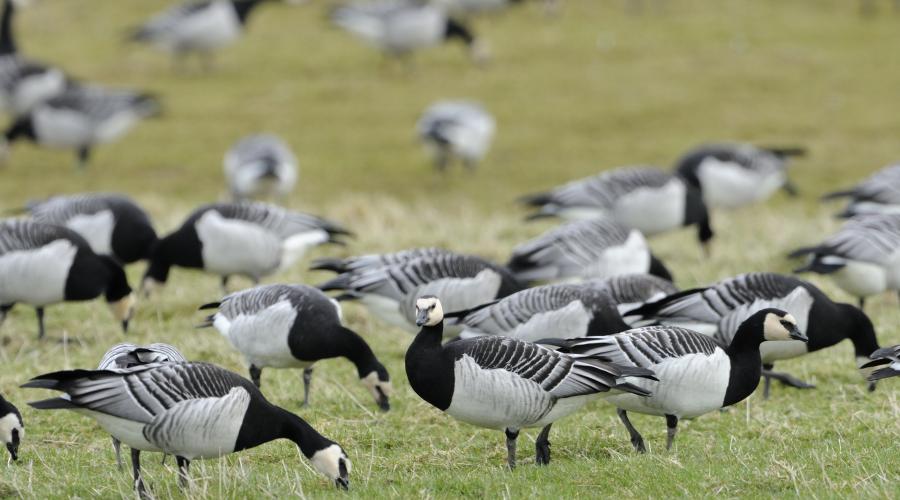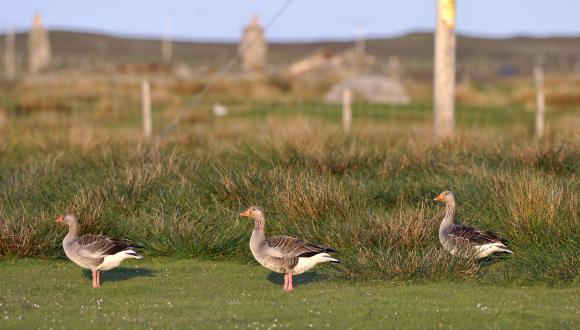
Islay Sustainable Goose Management Strategy
We launched a new sustainable goose management strategy to address agricultural and conservation interests on Islay in December 2014.
The Islay Sustainable Goose Management Strategy was developed in 2014 and will run until 2024. The Strategy aims to reduce damage to crops on Islay by reducing the number of Greenland barnacle geese and to maintain and increase the numbers of Greenland white-fronted geese by providing undisturbed feeding areas and trialling diversionary feeding.
The Strategy was developed as a result of increasing pressure on farming on Islay due to the damage caused by increasing numbers of barnacle geese and also due to concerns about the declining number of Greenland white-fronted geese.
The aim of the strategy is to deliver long term sustainable goose management on Islay using an adaptive management approach to wildlife management. The strategy will meet the national policy objectives for goose management, which are:
- meet the UK's nature conservation obligations for geese, within the context of wider biodiversity objectives
- minimise economic losses experienced by farmers and crofters as a result of the presence of geese
- maximise the value for money of public expenditure
Delivery of the Strategy is through the Islay Local Goose Management Scheme which is run by NatureScot on behalf of the local goose management group.
Read the Islay Sustainable Goose Management Strategy 2014–2024
The local goose management group has developed a scheme to deliver the strategy objectives.
Background to the strategy
Islay’s habitats are vital for Greenland barnacle geese and Greenland white-fronted geese, both of which are protected under European law.
The Greenland barnacle goose population has risen from about 20,000 birds in 1987 to more than 41,000 birds in 2014. But the rare Greenland white-fronted goose population is in decline, with around 5,000 birds present in 2014.
Yet high densities of protected geese cause damage to land and grass crops. Farmers have received funding since 1992 to partially compensate for their economic losses.
The partners who worked on the strategy were:
- NatureScot
- Scottish Government Rural Payments and Inspections Directorate
- National Farmers Union of Scotland (Islay branch)
Aims of the strategy
The strategy will support large numbers of Greenland barnacle and Greenland white-fronted geese on the island and help farmers whose land and crops are affected by the birds.
The aim is to reduce crop damage by around 25–35% by:
- decreasing the number of Greenland barnacle geese
- examining any new scaring techniques that become available while the strategy is live
- encouraging the ongoing scaring of geese
- helping farmers to manage their land more effectively
The strategy also aims to manage for the benefit of Greenland white-fronted geese by:
- improving habitat for Greenland white-fronted geese
- providing extensive areas of undisturbed feeding
- examining the option of providing diversionary feeding crops such as fodder beet
Adaptively managing the population of wintering geese should help to reduce impacts on farmers’ businesses, and the geese and their habitat.
More than 70% of the island will remain as undisturbed feeding areas for geese. This will include large areas of grassland on individual farms, RSPB reserves, rough grazing, dune grasslands, saltmarsh and roost areas.
In terms of the birds, the strategy aims to maintain:
- the Greenland barnacle goose population at a sustainable level
- and, if possible, increase the Greenland white-fronted goose population – by reducing disturbance, managing traditional feeding areas, and adding diversionary feeding
Contact
Rae McKenzie
Telephone: 0131 314 4155
Email: [email protected]




